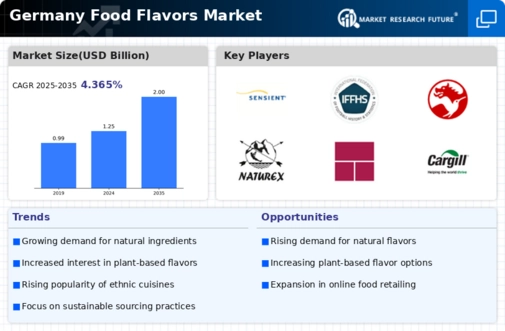Health and Wellness Trends
The increasing focus on health and wellness among German consumers is significantly impacting the food flavors market. As individuals become more health-conscious, there is a growing demand for flavors that complement healthier food options. This shift is evident in the rise of low-calorie and functional food products that incorporate natural flavors to enhance taste without compromising health benefits. The food flavors market is responding by developing flavors that align with dietary trends, such as plant-based and organic options. Recent statistics indicate that the market for health-oriented flavoring agents has expanded by 20% in the last year, highlighting the importance of health in flavor innovation.
Rising Demand for Authenticity
The food flavors market in Germany is experiencing a notable shift towards authenticity, driven by consumer preferences for natural and traditional flavors. This trend is reflected in the increasing sales of products that emphasize their origin and traditional preparation methods. According to recent data, approximately 60% of German consumers express a preference for food products that contain authentic flavors, which has led manufacturers to reformulate their offerings. The food flavors market is adapting by sourcing ingredients that are not only natural but also resonate with local culinary traditions. This demand for authenticity is likely to continue influencing product development and marketing strategies, as brands strive to connect with consumers on a deeper level.
Innovation in Flavor Technology
Technological advancements are playing a crucial role in the evolution of the food flavors market in Germany. Innovations in extraction and flavor enhancement techniques have enabled manufacturers to create more complex and appealing flavor profiles. For instance, the use of advanced extraction methods can enhance the potency of natural flavors, making them more desirable to consumers. The food flavors market is witnessing a surge in the introduction of novel flavor combinations, which cater to the adventurous palate of German consumers. This trend is supported by market data indicating that innovative flavor products have seen a growth rate of 15% in recent years, suggesting a strong consumer appetite for new experiences.
Cultural Influences on Flavor Preferences
Cultural diversity within Germany is significantly influencing the food flavors market, as consumers increasingly seek flavors that reflect global culinary trends. The integration of international flavors into traditional German cuisine is becoming more prevalent, driven by a younger demographic that is open to experimenting with diverse taste profiles. The food flavors market is responding by introducing flavors inspired by Mediterranean, Asian, and Latin American cuisines. Market analysis suggests that products featuring these international flavors have experienced a growth rate of 18% in recent years, indicating a strong consumer interest in multicultural culinary experiences. This cultural shift is likely to continue shaping the flavor landscape in Germany.
Regulatory Influences on Flavor Ingredients
The food flavors market in Germany is subject to stringent regulations regarding flavoring agents and additives. These regulations are designed to ensure consumer safety and product transparency, which has led to a shift in how manufacturers approach flavor formulation. The food flavors market must navigate these regulatory landscapes, often opting for cleaner labels and natural ingredients to comply with consumer expectations and legal standards. As a result, there is a growing trend towards the use of approved natural flavoring substances, which has been reflected in a 25% increase in the market share of natural flavors over synthetic alternatives. This regulatory environment is likely to continue shaping product offerings in the future.


















Leave a Comment